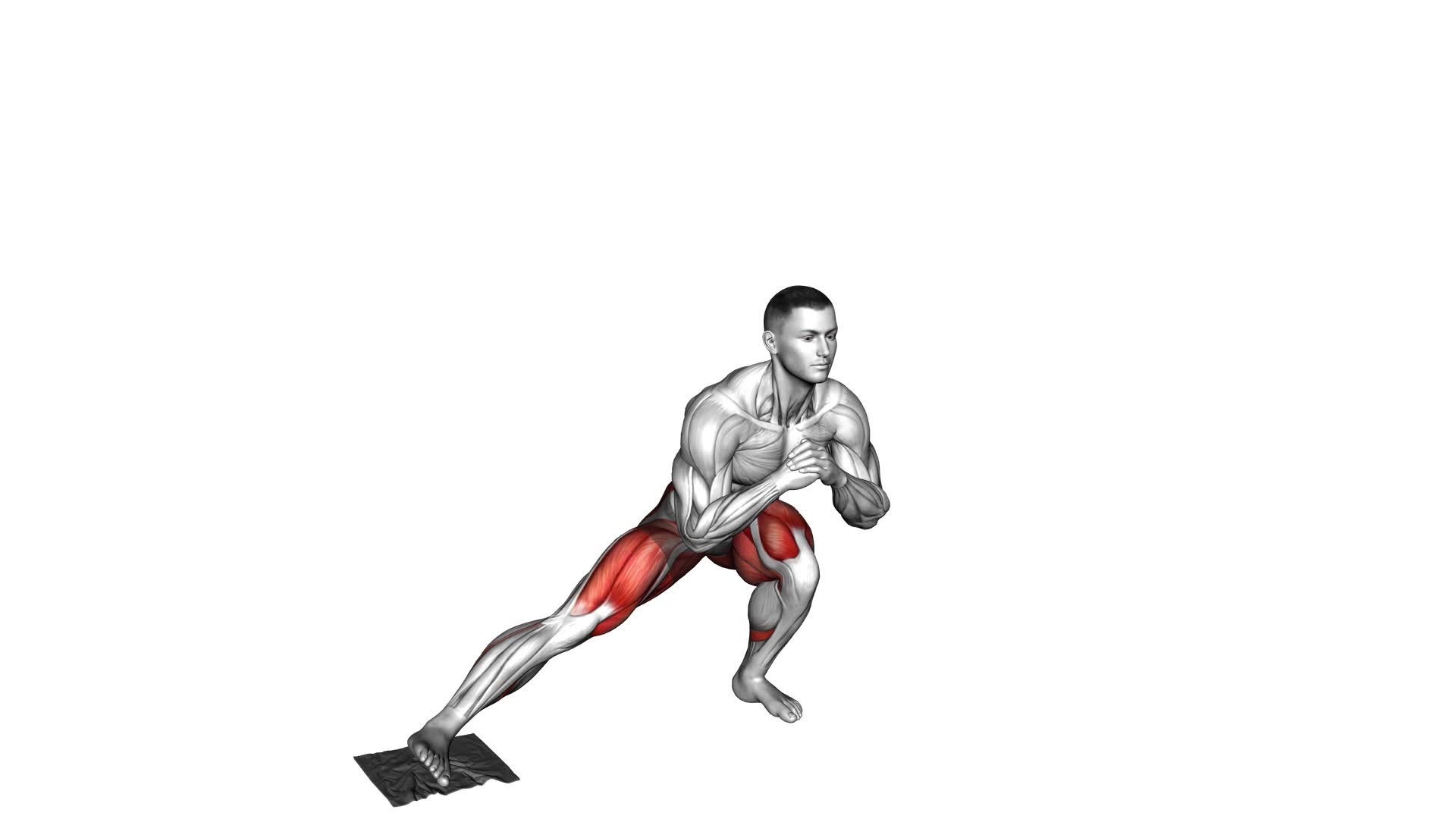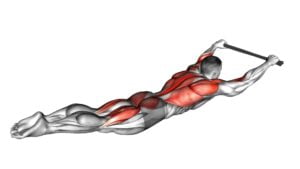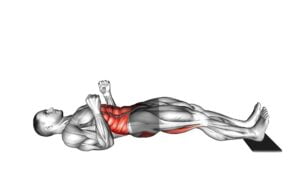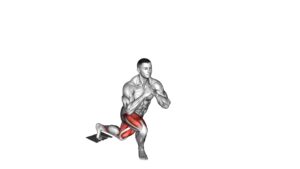Bodyweight Side Squat With Towel (Male) – Video Exercise Guide & Tips

Are you looking for a challenging lower body exercise that can be done at home? Look no further than the bodyweight side squat with a towel!
Watch This Exercise Video
This exercise targets your glutes, quads, and inner thighs, helping to strengthen and tone your lower body.
In this article, you'll find a detailed video exercise guide and helpful tips to ensure proper form and technique.
Whether you're a beginner or an experienced athlete, incorporating the bodyweight side squat into your workout routine is a great way to level up your fitness game.
Key Takeaways
- The bodyweight side squat targets and strengthens glutes and inner thighs.
- Proper form and technique include keeping knees in line with toes and maintaining a neutral spine.
- Variations such as weighted side squats, jumping side squats, and using a BOSU ball or balance board can challenge yourself and increase muscle activation.
- Beginners should start slow, focus on form, engage the core, and incorporate modifications to gradually increase difficulty.
Benefits of the Bodyweight Side Squat
One of the benefits of the bodyweight side squat is its ability to target and strengthen your glutes and inner thighs. This exercise is particularly effective in improving balance and targeting both the inner and outer thighs. By performing the bodyweight side squat, you engage the muscles in your lower body, helping to tone and strengthen them.
When you perform the bodyweight side squat, you shift your weight onto one leg while extending the other leg out to the side. This movement targets the glutes, inner thighs, and outer thighs, helping to build strength and definition in these areas. Additionally, the side-to-side movement challenges your balance, forcing your core muscles to engage and stabilize your body.
By regularly incorporating the bodyweight side squat into your exercise routine, you can improve your overall balance and stability. This exercise not only targets specific muscle groups but also requires coordination and control, making it a great addition to any workout program.
Now that you understand the benefits of the bodyweight side squat, let's move on to discussing proper form and technique to maximize its effectiveness.
Proper Form and Technique
To ensure maximum effectiveness and avoid injury, it's important to maintain proper form and technique while performing the bodyweight side squat. By following these guidelines, you can optimize the benefits of this exercise and reduce the risk of strain or muscle imbalances.
One common mistake to avoid is allowing your knees to cave inwards during the movement. This can put excessive stress on your knee joints and compromise your stability. Instead, focus on keeping your knees in line with your toes throughout the entire range of motion.
Another important aspect of proper form is to maintain a neutral spine. Avoid rounding or arching your back during the exercise, as this can lead to strain on your lower back. Keep your chest lifted and engage your core muscles to stabilize your spine.
To activate the correct muscles during the bodyweight side squat, it's crucial to push through your heel as you return to the starting position. This will engage your glutes and outer thigh muscles, providing a more effective workout.
Variations to Challenge Yourself
To challenge yourself, you can explore different variations of the bodyweight side squat. These advanced modifications not only add variety to your workout routine but also increase muscle activation, leading to greater strength and gains.
One variation you can try is the weighted side squat. Instead of using just your bodyweight, hold a dumbbell or kettlebell in each hand as you perform the exercise. This added resistance will engage your muscles even more, making the movement more challenging.
Another option is the jumping side squat. Start in a squat position and explode upwards, jumping to the side and landing in a squat position on the opposite side. This plyometric variation adds an element of cardiovascular fitness and explosiveness to the exercise.
Lastly, you can incorporate a balance challenge by performing the bodyweight side squat on a BOSU ball or a balance board. This unstable surface forces your muscles to work harder to maintain stability, enhancing muscle activation and core engagement.
Tips for Beginners
If you're new to the bodyweight side squat, here are some helpful tips to get you started:
- Don't rush: One of the most common beginner mistakes is trying to go too fast. Remember to start slow and focus on your form. This exercise requires balance and stability, so take your time and make sure you're doing it correctly.
- Engage your core: A common misconception with side squats is that they only work your legs. While they do target your glutes, quads, and hamstrings, it's important to engage your core as well. This will improve your balance and stability, and also help prevent any lower back pain.
- Use a towel for support: Another mistake beginners often make isn't using any support. You can place a towel under your foot to provide some extra stability. This will allow you to focus on your form and technique without worrying about losing your balance.
Incorporating the Bodyweight Side Squat Into Your Workout Routine
How can you effectively incorporate the bodyweight side squat into your workout routine?
The bodyweight side squat is a great exercise for targeting the muscles in your legs, particularly the quads, glutes, and inner thighs. To ensure you perform the exercise correctly and maximize its benefits, it's important to avoid common mistakes.
One common mistake to avoid is collapsing your knees inward as you squat down. This can put excessive strain on your knee joints and increase the risk of injury. Instead, focus on keeping your knees in line with your toes throughout the movement.
Another mistake to avoid is leaning too far forward or backward. This can compromise your form and decrease the effectiveness of the exercise. Maintain an upright posture throughout the movement, with your chest lifted and your core engaged.
To modify the bodyweight side squat for different fitness levels, you can make a few adjustments. If you're a beginner, you can start by performing the exercise without any added resistance. As you become more comfortable and stronger, you can gradually increase the difficulty by holding a dumbbell or kettlebell in each hand.
For those who are more advanced, you can add a jump to the side squat to make it more challenging and incorporate some plyometric training into your routine.
Incorporating the bodyweight side squat into your workout routine can help improve your lower body strength and stability. By avoiding common mistakes and modifying the exercise to suit your fitness level, you can make the most out of this effective exercise.
Frequently Asked Questions
How Many Calories Can I Burn by Doing the Bodyweight Side Squat?
You can burn a significant amount of calories by doing the bodyweight side squat. The exact number of calories burned will depend on various factors such as your weight, intensity, and duration of the exercise.
However, incorporating the bodyweight side squat into your workout routine can contribute to overall calorie burn and help strengthen your lower body muscles.
It's important to maintain proper form and gradually increase the intensity to maximize the calorie-burning potential of this exercise.
Can the Bodyweight Side Squat Help Improve Flexibility?
The bodyweight side squat is a great exercise for improving flexibility. By incorporating this exercise into your workout routine, you can increase your range of motion and improve the flexibility of your hips, glutes, and thighs.
Additionally, the bodyweight side squat is an effective way to strengthen and define your leg muscles. To progress this exercise, you can try variations such as adding resistance or incorporating balance challenges.
Keep pushing yourself and you'll see improvements in both strength and flexibility.
Is It Safe to Perform the Bodyweight Side Squat if I Have Knee Problems?
If you have knee problems, it's important to consider alternatives to the bodyweight side squat. While this exercise can be beneficial for strengthening the lower body, it may put strain on your knees.
Instead, focus on exercises that are low-impact and less stressful on the joints, such as leg presses or seated side leg lifts.
Always prioritize proper form and technique to ensure you're protecting your knees and preventing further injury.
How Long Does It Take to See Results From Doing the Bodyweight Side Squat?
To see results from the bodyweight side squat, it's important to incorporate it into your workout routine consistently.
The exercise targets your glutes, quads, and inner thighs, helping to tone and strengthen those areas.
By performing the side squat with proper form and technique, you can maximize the benefits and minimize the risk of injury.
Keep your back straight, chest up, and push through your heels as you lower into the squat.
Can the Bodyweight Side Squat Help Improve My Balance and Stability?
The bodyweight side squat can definitely help improve your balance and stability. By engaging your core muscles and working on the lateral movement, this exercise challenges your body in a different way, ultimately enhancing your overall stability.
Additionally, there are various variations of the bodyweight side squat that you can try to further target different muscles and add variety to your workout routine.
Incorporate this exercise into your fitness regimen to see improvements in your balance and stability.
Conclusion
Incorporating the bodyweight side squat into your workout routine can help improve your lower body strength, stability, and balance. By using proper form and technique, you can target the muscles in your hips, thighs, and glutes effectively.
Additionally, there are variations available to challenge yourself as you progress. Whether you're a beginner or more experienced, this exercise can be a valuable addition to your fitness regimen.

Author
Years ago, the spark of my life’s passion ignited in my mind the moment I stepped into the local gym for the first time. The inaugural bead of perspiration, the initial endeavor, the very first surge of endorphins, and a sense of pride that washed over me post-workout marked the beginning of my deep-seated interest in strength sports, fitness, and sports nutrition. This very curiosity blossomed rapidly into a profound fascination, propelling me to earn a Master’s degree in Physical Education from the Academy of Physical Education in Krakow, followed by a Sports Manager diploma from the Jagiellonian University. My journey of growth led me to gain more specialized qualifications, such as being a certified personal trainer with a focus on sports dietetics, a lifeguard, and an instructor for wellness and corrective gymnastics. Theoretical knowledge paired seamlessly with practical experience, reinforcing my belief that the transformation of individuals under my guidance was also a reflection of my personal growth. This belief holds true even today. Each day, I strive to push the boundaries and explore new realms. These realms gently elevate me to greater heights. The unique combination of passion for my field and the continuous quest for growth fuels my drive to break new ground.







